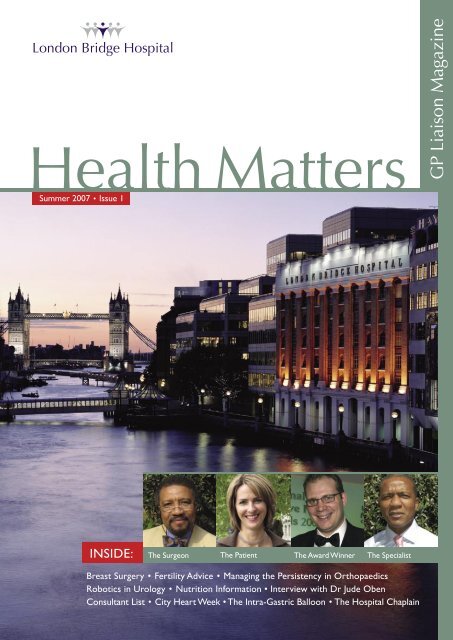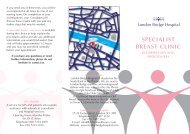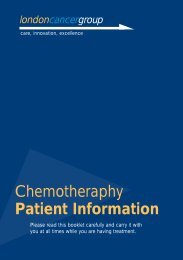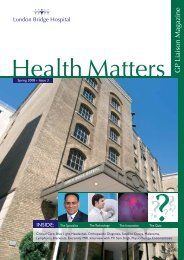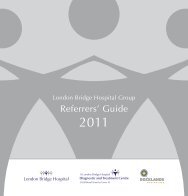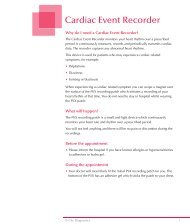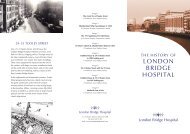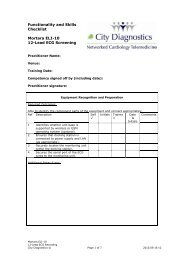407260LBH Health Matters.indd - London Bridge Hospital
407260LBH Health Matters.indd - London Bridge Hospital
407260LBH Health Matters.indd - London Bridge Hospital
Create successful ePaper yourself
Turn your PDF publications into a flip-book with our unique Google optimized e-Paper software.
IntroductionWelcomeWelcome to the new version of our GP Liaison Magazine,I hope you find the information useful and we welcome yourfeedback for future publications.Since our last issue, the following services are available at29 Tooley Street:• Women’s Centre• One Stop Breast Clinic• One Visit Gynaecology Clinic• Chemotherapy Day Unit.The outpatient centre at 31 Old Broad Street will celebrate oneyear since opening in June last year. It has become the preferredchoice for City professionals because it is conveniently located,allowing lunchtime diagnostic tests and consultations. This centreis open Monday – Thursday 8am-8pm and Friday 8am-6pm.Docklands <strong>Health</strong>care has become an established preferencefor City professionals in Canary Wharf. This centre is openMonday – Thursday 8am-8pm and Friday 8am-6pm.Our City Heart Week promotion takes off on 11 June thismonth and our 2007 Referrer Guide has been published. Shouldyou wish to receive a copy, please contact us on 020 7234 2373.We are currently looking at ways to standardise and streamlineour admissions/registration process and patient journey at <strong>London</strong><strong>Bridge</strong> <strong>Hospital</strong> and all other HCA facilities. The SAFE project teamis represented by all facilities and will be implementing changesbetween now and August.We are constantly improving our services and equipment.Our staff and specialist consultants strive, at all times, to makethe patients experience as comfortable and stress free as possibleand, in doing so, we hope we are able to offer the first classservice expected.Amanda ShawGP Liaison Department2
FeaturesFeaturespgBreast Surgery4 One Stop Breast Clinic4 Familial Breast Cancer Challenge that Warrants Multidisciplinary Specialist Care5 My Experience6 Breast Duct Microendoscopy Shedding Light on Breast CancerInfertility7 Advice to Couples Concerned about Delays in ConceptionOrthopaedic8 Managing the Persistently Painful Ankle SprainPalliative Care8 Nursing Award Ceremony 2007Urology9 Robotics in UrologyGastroenterology10 The Intra-Gastric Balloon A New Innovation for Weight LossSinusitis10 City Sinus Clinic<strong>Health</strong>y Living11 Nutritional Information11 <strong>London</strong> <strong>Bridge</strong> HolisticsInterview12 10 Minutes With Dr Jude ObenConsultants13 New <strong>London</strong> <strong>Bridge</strong> <strong>Hospital</strong> Consultant ListNew Services14 <strong>London</strong>’s First Private Fracture Clinic • Balloon Sinuplasty • Dr Peter K Thompson15 <strong>Hospital</strong> Chaplain • The <strong>London</strong> Vascular GroupArticles16 <strong>London</strong> <strong>Bridge</strong> - The Destination on Your DoorstepComing Soon in September18 Orthopaedic Lunch-time Seminar WorkshopCardiology19 First City Heart Week Launches With Free Heartbeat Checks3
Breast SurgeryBreast Duct Microendoscopy:Shedding Lighton Breast CancerMedicine and surgery are currently undergoing a strong trend tominiaturisation. Diagnostic tests and surgical operations are consequentlymore easily tolerated, with less pain and less time needed for recovery.Miniaturisation also means that interventions can be more detailed andcan have access to areas of the body that were previously difficult toinvestigate. One example of this is endoscopy. Fibre optic scopes providea non-invasive route to more accurate diagnosis and minimally invasivetreatments. Now this new technology is being applied to the diagnosis ofBritain’s most common malignancy: breast cancer.A 0.5mm PD Scope6More than 40,000 women are diagnosedwith breast cancer in the UK every yearand it is the most common cause ofdeath in women in their 30s and 40s.Although the treatment is becomingmore successful, the number of casesdiagnosed each year continues to rise.There are proven risk factors relating toour Western lifestyle, such as our diet,the trend to having our children later,smaller families, and the prolonged useof HRT, but it is a worldwide problemand the specific cause is unknown. Whatis very clear, is that the cells that line themilk ducts of the breast are much moreliable to undergo cancerous changethan other types of cell in the body, andit is from these cells that breast cancerarises. The change from a normal cell toa breast cancer cell is a gradual one andtakes years, during which time the cellsbecome more and more abnormal.Breast cancer diagnosis and imaging haveimproved enormously over the last 15years. Mammograms, ultrasounds andMR (Magnetic Resonance) scans enablevery detailed investigation of the breast.Lumps measuring just a few millimetres,can now be identified, and breast canceris being caught at an earlier stage.However, none of these investigationshave the ability to examine the lining ofthe milk ducts. As a consequence, thegradual change towards malignancy isonly occasionally identified before thecells undergo the final change into breastcancer. At this point, the cells developthe ability to invade and move out ofthe milk duct, forming a lump that maybe felt or identified on a mammogramor ultrasound. Until this time, the cellsmay have the appearance of cancer cellsbut being confined to the milk duct, theyare entirely harmless. Once invasive, thecancer cells can escape from the milkducts and from the breast, spreading toother areas of the body and ultimatelycausing death. In breast cancer, it really istrue that prevention is better than cure.Diagnosis at the early, pre-invasive stageavoids the possibility of cancer spread,simplifies treatment and undoubtedlysaves lives.The early identification of pre-invasivebreast cancer (ductal carcinoma in situ)is, in many ways, the simplest answer tothe problem of breast cancer. It shouldbe possible, particularly considering thefact that these changes occur over manyyears. However, our advances in breastimaging have all been towards identifyingsmaller and smaller invasive cancer lumps,but have made very little progress in thedirection of identifying abnormal cellswithin the milk ducts, before invasivecancer develops.The solution may lie in the ‘dramatic’ newtechnology, breast duct microendoscopy.I feel that it is justified to call it dramatic,because not only is it a completelynew way of looking at the breast, butthe first instruments were developedby two optical technicians workingin the film industry in Hollywood.Breast duct microendoscopy utilisesmicroendoscopes, which have across-sectional diameter of less thana millimetre. They enter the milk ductthrough the natural openings on thetip of the nipple, and provide magnifiedpictures of the lining of the milk ducts.This is the first time that it has beenpossible to directly assess the cells thatline the milk ducts of the breast.The very earliest instruments ofthis type were designed and built inCalifornia, but the first hospital to carryout the technique in Europe was Guy’s& St Thomas’ in <strong>London</strong>. Radically newdevelopments such as these, are oftentoo speculative for the major medicalinstrument manufacturers, and afterobtaining our initial instruments from asmall specialist manufacturer in the UnitedStates, we have worked with a smallGerman optical engineering company tomanufacture and constantly update ourinstruments. After 5 years’ development,we have made more advances than anyonein this field, and our manufacturer is nowthe market leader.Breast duct microendoscopy has alreadybecome a routinely-used technique inpatients with nipple discharge. Again,mammograms and ultrasounds rarelyshow the cause of nipple discharge, whichmay occasionally be due to malignancy.As a consequence, many patients havea diagnostic operation to removethe discharging milk duct. Breast ductmicroendoscopy has not replaced thisoperation altogether, but when combinedwith an operation, it enables the surgeonto confidently identify the part of theaffected milk duct and concentrate on this,rather than blindly removing the wholeduct. A much more valuable role wouldbe to diagnose pre-invasive breast cancer.This type of investigation would not besuitable for the whole population as inmammographic screening, but wouldtarget women with a particularly high riskof breast cancer. This includes patients withcertain genetic abnormalities thatpredispose to breast cancer, or with astrong family history of breast cancer.Another group of patients would be
those women who have already hadbreast cancer on one side, and who,as a consequence, have a much higherrisk of developing breast cancer in theopposite breast in the future. Breastduct microendoscopy can be carriedout under a local anaesthetic, and is,surprisingly, not a painful procedure.The technology is still very new, andits place in the screening of high-riskwomen for pre-invasive malignancy isstill a few years away. Although we havebeen able to make significant advances,and in many respects still lead thefield in this exciting new development,research funding through the NHS is inreality very poor, and the developmentsare much slower than we would like.As is often the case, we may have torely on better-funded research in thebigger universities in the United Statesto carry this forward. Without significantfunding, we may still be able to make acontribution through daring innovation.Our team at Guy’s & St Thomas’ arecurrently in the final stages of adaptingour breast microendoscopy system intoa powerful microscope, that we believewill not only be able to examine thelining of the milk duct, but will be able tomagnify sufficiently to see the individualcells. This would be a world first, and anastonishing feat when you consider thatwe will be examining living tissue, wherebreast diagnosis currently only usestissue that has been removed from thebody and fixed in formalin.Breast duct microendoscopy is certainlya dramatically different new way ofexamining the breast. It has been madepossible by continued developments inmicro-optical engineering, and has beenpioneered here in <strong>London</strong>. It remainsto be seen, however, whether thistechnical innovation can be translatedinto practical ways of improving thediagnosis of pre-cancerous changes inthe breast. It is an example of just one ofthe directions in which the diagnosis andtreatment of breast cancer has improvedso much over the last twenty years.Mr Nicholas Beechey-NewmanConsultant Breast SurgeonAdvice to CouplesConcerned aboutDelays in ConceptionApproximately 1 in 8 couples will report some delay in conceiving. Thiscan lead to a great deal of anxiety and some simple advice may help toallay anxiety and help them achieve a pregnancy.Couples concerned about their fertility can be reassured that it can take up to ayear or more to conceive, and should be advised that approximately 60% of womenwill conceive within 6 months and 85% within 1 year. Investigations are thereforenormally commenced when a couple have been trying to conceive for one year ormore without success. Investigations can be considered earlier (6 months), if there arespecific reasons for concern, such as couples where the woman is 35 years or older.A history of irregular periods may suggest problems with ovulation. A history of pelvicinflammatory disease or pelvic surgery will increase the possibility of damage to thefallopian tubes and early referral for further investigations should be considered.Many couples trying for a pregnancy try to schedule sexual intercourse aroundthe time of ovulation in an attempt to maximise the possibility of conception.Timing ovulation, can be very difficult, even when using the home testing kits. In anycase, trying to time sex is rarely helpful and is not recommended, as it can lead toincreased stress. Once ovulation takes place, the egg will survive for 24 hours butsperm can survive for up to seven daysafter ejaculation. Sexual intercourse,therefore, every 2 to 3 days will optimisethe possibility of conception, without theneed to time sexual intercourse.A healthy balanced diet is importantwhen trying for a pregnancy. Womenshould be advised to take Folic Acidsupplements before conception and upto 12 weeks’ gestation to reduce therisk of neural tube defects (spina bifida).Other dietary supplements, such asmultivitamins, are of no benefit.Obesity is associated with loss of fertility and increase in pregnancy complications.Women who are underweight, Body Mass Index (BMI) of less than 19 may alsoexperience difficulty in conceiving. Ideally, women planning a pregnancy should have aBMI that is in the normal range (20-25).Couples trying for a pregnancy should be advised on lifestyle. Excessive alcoholconsumption in men is known to affect sperm quality. The effects on female fertilityare less clear, but excess alcohol consumption is harmful to the fetus and womentrying to conceive are advised to drink in moderation and avoid binge drinking.Drugs, such as marijuana and cocaine, can adversely affect fertility in both men andwomen and should be avoided. Some prescription drugs can also affect fertility orhave adverse effects in pregnancy, and further advice should be sought from theprescribing doctor.There is an association between smoking and reduced fertility in women. Smokingcan have a negative effect on sperm quality, therefore, both males and females shouldbe advised that giving up smoking may help increase the likelihood of achieving apregnancy, as well as improving their general health.Women trying to conceive should ensure that their cervical smears areup-to-date, not because abnormal smears are associated with infertility, but becausethe treatment of abnormal smears is usually delayed if the woman is pregnant.Couples concerned about their fertility should be reassured that the majority will besuccessful by 12 months. However, if they are unsuccessful they should be referred forspecialist investigation.Mr Michael SavvasConsultant Gynaecologist“Couples concerned abouttheir fertility should bereassured that the majoritywill be successful by12 months. However, ifthey are unsuccessful theyshould be referred forspecialist investigation.”Infertility7
Palliative Care | OrthopaedicManaging the PersistentlyPainful Ankle SprainPersistent pain after an ankle sprain represents a difficult clinical problem,with patients often presenting late to the General Practitioner. This articleexplores causes of persisting ankle pain and its management.Sam Singh is an Orthopaedic Foot andAnkle Consultant at Guy’s & St Thomas’and at <strong>London</strong> <strong>Bridge</strong>. After completingtraining in <strong>London</strong>, he undertook furthersub-specialist training at Harvard in Footand Ankle Surgery. His specialist areasof interest include ankle sports injuries,tendon disorders, ankle arthritis andhallux valgus.The ankle has three main ligaments– the lateral ligament, the medial deltoidligament and the syndesmotic ligaments.The horizontal anterior talofibularligament, part of the lateral ligamentcomplex, is most commonly injured andis palpated by starting at the tip of thefibula and moving anterior, while applyingan inversion or inwards twist to theankle. The ligaments of an acutely swollenankle are difficult to assess. It is worthchecking the medial ligaments, as medialtenderness is associated with a fracture.Two other bony landmarks that shouldbe palpated include the base of the 5thmetatarsal and the proximal fibula, as bothare also fractured by an inversion injury. Ahigh fibula fracture may be the final resultof a twisting force that has torn all theligaments and the interosseus membraneholding the tibia and fibula together.In an acute injury, excessive pain,deformity and the inability to weightbearare indications for an x-ray. RICE– Rest, Ice, Compression and Elevation,can adequately manage most sprains.Physiotherapy is the first step in restoringa patient’s confidence and stability intheir ankles. Local modalities help controlswelling, while functional rehabilitationstrengthens muscles around the ankle thatcan replicate some of the function of theligaments. Balance exercises, such as thewobble board, teach patients to recruitthese muscles when they feel their ankleis giving way. Pain and swelling persistingbeyond two weeks, may be from amore severe soft tissue injury, a missedfracture or joint cartilage damage. Thesepatients may benefit from referral to anOrthopaedic Consultant.Chronic instability of the ankle is a moresubtle injury. It may just be that patientsexperience pain on exercise, or lackconfidence when walking in certainshoes or on uneven surfaces, feelinghappier indoors than in a park or on thegolf course.8Jonathan CanhamInternational Journal of Palliative NursingAward Ceremony 2007, Savoy Hotel <strong>London</strong>The runners-up and winners of this year’s International Journal of PalliativeNursing Award Ceremony 2007 were announced in the grand surroundingof the Savoy Hotel in <strong>London</strong>. The atmosphere was one of celebration,high emotions and suspense, as specialised nurses providing emotionalsupport, pain and symptom relief for terminally ill patients, were called tothe stage to be honoured for their achievements.Awards were won in six differentcategories. Peers in palliative care judgedall the nominations for these awards,recognizing and marking commitmentand special achievements. Winner ofthe Development Award was JonathanCanham, <strong>London</strong> <strong>Bridge</strong> <strong>Hospital</strong>,<strong>London</strong>, for outstanding work in initiatingand setting up palliative care servicefor patients in the independent sectorand a model replicated in other privatehospitals. The service, which JonathanCanham initiated, has received excellentfeedback from patients, consultants andoutside agencies.In the category of Educationalist of theYear, the winner was Kerry Macnish fromHospiscare in Exeter, Devon. She waspraised for her enormous contribution inpiloting an education course for nurses tomanage breathlessness in the very sick.The next category honoured theachievements made in Non-CancerSymptom Management, such as caringfor elderly and frail dementia patients,sufferers of Multiple Sclerosis and lookingafter patients affected by Motor NeuroneDisease. The prize was given to the MotorNeurone Disease Clinical Team at theWisdom Hospice in Medway, Kent fortheir extraordinary pioneering work.One of the most emotional speecheswas given by the joint winner of theMultidisciplinary Teamwork Award,Valerie Maasdorp from the IslandHospice and Bereavement Service inHarare, Zimbabwe. She pointed outthat Zimbabwe has the highest ratio of
Recurrent sprains restrict recreationalactivities and they are at a high risk ofcartilage damage and arthritis in laterlife. Unlike the hip or knee, most anklearthritis is a direct result of trauma.Surgery is considered when, afternon-operative treatment, usually inthe form of physiotherapy or bracing,has failed to improve the patient’ssymptoms. Further investigation withan MRI is useful to exclude othercauses of ankle instability or pain.Significant joint pathology, such ascartilage defects or excessive scartissue, can be treated arthroscopically.At surgery, the lesions are debridedand the hard subchondral bone is‘micro fractured’ with a pick. Thiscauses inflammation and bleeding,which stimulates protective junkcartilage formation.My lateral ligament reconstructionof choice is a Brostrum procedure.In this, the remnant of anteriortalofibular ligament and calcaneofibularligament are detached from the bonewith a cuff of tissue. They are advancedand reattached in a bony groove.This tightens the ligament and treatsthe instability.Mr Sam SinghConsultant Orthopaedicand Foot and Ankle Surgeonorphans to adults in the world, causedby HIV-AIDS. She and her team have thetraumatic job of training and supportingyoung carers, mostly children, who areleft in charge of their dying parents andsiblings. Sharing the winning award wasWendy Jane Page from the Princess Royal<strong>Hospital</strong> in Hull, for developingand implementing a palliative careout-of-hours telephone advice line in Hull.The category for Palliative Care Nurse ofthe Year received a lot of attention. Thewinner was Jacqui Scrace, a children’snurse from the Royal Hampshire County<strong>Hospital</strong> in Winchester, Hampshire inrecognition for the holistic care andsupport she provides to the whole family,after a life-threatening illness has beendiagnosed.A highly emotional reception andstanding ovation was given to therecipient of this year’s LifetimeAchievement award, Philip Joseph Larkin,for his distinguished career in the practiceand research of palliative care which isrecognised in Ireland, the UK, Europeand beyond. The announcement of thisprize brought this extraordinary eveningto an end. The International Journal ofPalliative Nursing staged this event, withits principal sponsor, Macmillan CancerRelief, as well as Roche.Roboticsin UrologyRecent years have seen a massive expansion in the use of robots withinsurgery in general. Urology has emerged at the forefront of surgicalrobotics, spearheaded by the increasing use of the Da Vinci surgicalsystem (Intuitive Surgical, California, USA) for robotic-assisted radicalprostatectomy. Over 400 Da Vinci robots are now in use worldwide, thevast majority of which are based in North America, although there areseven systems in the UK.Whilst radical prostatectomy for prostate cancer at present, undoubtedly, makes up thevast majority of robotic-assisted procedures worldwide, use in radical cystectomy forbladder cancer and pyeloplasty for poorly draining kidneys, is also increasing.Da VinciThe Da Vinci System remains the state-of-the-art surgical robot. It has 3 components:• Surgeon’s Console which is placed outside the surgical field and is fitted with3-dimensional binocular stereo viewer. The surgeon sits at the console and holds themaster grips to control the instruments and the camera.• Instruments and camera are attached to the ‘surgical cart’ which consists of a columnand a base.• Vision cart allows the assistants to visualise the operative procedure and assist thesurgeon. The surgeon operates at the console and his/her hand movements areintuitively translated into movements of the robotic arms, while filtering out the tremor.The arms incorporate ‘endowrist’ technology that allows them six degrees of freedom,despite the fact that they are sited in the patient via minimally invasive ports. The mainadvantages of employing robot over conventional laparoscopy are, superior optics,greater freedom of movements of the instruments and better ergonomic comfort forthe operating surgeon. In addition to its rapidly expanding use in the field of urology,the Da Vinci robot has also been used successfully in the fields of cardiac, endocrine,upper gastro-intestinal and colorectal surgery.Prostate CancerWith increased Prostate Specific Antigen (PSA) testing, GP Well Man check-ups, and ageneral improvement in awareness of men’s health, the number of relatively young Britishmen diagnosed with localised prostate cancer is steadily increasing. Surgery, in the formof a radical prostatectomy to remove the entire prostate, is one of a number of optionsfor patients in this situation. The operation, although effective, has a number of side effectsand potential complications, particularly when performed by the open surgical technique.The proven advantages of minimally invasive surgery make this operation more attractivewhen a robot is used, as rates of blood loss, scarring, hospital stay and recovery aresignificantly reduced. With robotic assistance, there are also the potential advantages ofimprovement in post-operative incontinence and impotence rates, due to the improvedvision and dexterity when using the Da Vinci system.Urology and robotics are now intertwined. Robotic techniques have been shown to bemore effective than traditional methods for some procedures and, in the era of evidencebased practice, this cannot be ignored. It is important that surgeons and manufacturersstrive to ensure that the technology is refined, such that it can be readily integrated acrossother systems to provide the best ergonomic instrumentation for future procedures.Widespread media coverage has increased patient awareness of the possibilities whichrobotic surgery offers, and has led to a market-driven demand for robotic surgery.However, good quality evidence prospectively comparing robotic to conventional openand laparoscopic surgery, is mandatory. The dramatic evolution of robotic surgery overthe past 10 years is likely to be eclipsed by even greater advances over the next decade.Mr Mohammad Shamim Khan – Consultant Urological SurgeonDepartment of Urology, Guy’s & St Thomas’ <strong>Hospital</strong>, <strong>London</strong>.Mr Prokar Dasgupta – Consultant Urological SurgeonDepartment of Urology, Guy’s & St Thomas’ <strong>Hospital</strong>, <strong>London</strong>Urology9
Sinus Clinic | GastroenterologyThe Intra-Gastric Balloon:A New InnovationFor Weight LossObesity is a worldwide problem. The health consequences of being obeseare extensive and include heartburn, high blood pressure, diabetes, heartdisease, arthritis, liver failure and cancer. Being obese shortens lifespan.It is for this reason that the Government has wisely made fighting obesitya national health priority. If you are the 1 in 4 of the UK population whois deemed unhealthily overweight (obese) with a BMI greater than 35kg/m2, (i.e. your weight in kilos divided by your height in metres squared isgreater than 35) and want to lose weight, then help is at hand.Although the initial line of therapy is toalter behaviour in relation to food andto increase the level of exercise, we allknow how difficult that can be. Just likegiving up smoking, it can be difficult tolose weight.Medical help is available and iseffective when used in combinationwith behavioural and diet changes.The treatment ladder would usuallyinvolve advice from a dietician andpsychological support from a mentalhealth professional, if required. Thiswould be followed by the prescription ofmedication that reduce the absorptionof fat from the diet – orlistat or suppressappetite – sirbutramine or rimonabant. Ifthese measures are ineffective, the nextstep is to place into the stomach, withthe help of an endoscopic camera, undersedation, a specially designed, liquid-filled,silicone balloon.This innovation offers a safer, simplerand reversible alternative to restrictivestomach surgery – gastric bands andstomach bypass operations both ofwhich are major procedures requiring ageneral anaesthetic. A general anaestheticmay be particularly hazardous in theobese. These major operations, untilnow, have been the only options offeredto patients after pills have failed. Theadvent of balloon therapy is particularlywelcomed for this reason and becausethe balloon can also be placed in patientscontemplating having other surgery,who need to reduce their operativeobesity-related risks prior to surgery.The endoscopic procedure takes about20 minutes and, after an overnight stay inhospital to ensure tolerance of the balloon,the patient is discharged. Recent publishedevidence shows impressive results withthe balloon. It is designed to stay in thestomach for up to 4-6 months and is alsoremoved endoscopically under sedation.A treatment course would usually involve2 balloons placed sequentially over a 12-month period.Dr Jude Oben offers this innovativetreatment as part of a multi-layeredapproach to obesity treatment at The<strong>London</strong> <strong>Bridge</strong> <strong>Hospital</strong>. Dr Oben isan Oxford and Johns Hopkins trainedConsultant Gastroenterologist/Hepatologistwith sub-specialty interest and researchexpertise in liver disease and obesity.Dr Jude ObenConsultant Gastroentorologist/Hepatologistand General Medicine SpecialistCity Sinus ClinicSinus problems are very common. Some studies suggest 16% of<strong>London</strong>ers may have sinusitis. Sinusitis is often underrated as a medicalcondition. It seriously affects quality of life but fortunately it can betreated very successfully.Sinusitis is an inflammation of thesinuses and sufferers can experience awide variety of symptoms, but it oftenfeels like having a permanent cold.Most patients respond well to medicaltreatment using a combination ofantibiotics, nasal steroid sprays, irrigationsand allergy treatments. Some of thesetreatments only provide temporaryrelief. These patients often benefitfrom further investigations and mayneed surgery in order to address theunderlying cause of their sinusitis.Your SurgeonMr David Roberts FRCS (ORL) isa Consultant Ear, Nose and Throatsurgeon appointed to Guy’s andSt Thomas’ <strong>Hospital</strong>s NHS Trust. He isaccredited by the Specialist AdvisoryCommittee in Otorhinolarygology– Head and Neck Surgery, and hasbeen awarded his Certificate ofSpecialist Training by the authority ofthe Medical Royal Colleges. He is aFellow of the Royal College of Surgeonsof England and a member of the BritishAssociation of Otorhinolarygology andthe European Rhinology Society. Heis the <strong>London</strong> Representative to theBritish Rhinological Society.How to Get in TouchThe City Sinus Clinic is held on a Tuesdayevening at 31 Old Broad Street from5pm to 8pm and appointments can bemade by telephoning:GP Liaison on: 020 7234 2120/2009between 9am and 5.30pm, Mondayto Friday. Or by emailing:gpliaisonlbh@hcahealthcare.co.ukCity Sinus Clinic now offers an additionaltechnique for sinus surgeons, BalloonSinuplasty, a new technique for sinusitissufferers. Please turn to page 14 formore details.10
Nutritional InformationCARBOHYDRATESThis includes all the sugars and starches(carbohydrate) within the food.SUGARSThe ‘sugars’ content will includenaturally-occurring sugars such asmilk sugars (lactose) and fruit sugars(fructose), plus any added sugars(dextrose, sucrose). Avoid products withlots of added sugars, check by readingthe ingredients list.FATThis includes saturated fat,polyunsaturated fat and monounsaturatedfat. Limit all fats, especially saturated fat.Polyunsaturated and monounsaturatedare healthier choices.Susan KeanOutpatient DieticianPROTEINPeople generally tend to eat moreprotein than we require in our diet.Try and choose protein sources lower infat, especially saturated fat.ENERGYNUTRITIONAL INFORMATION TYPICAL VALUESENERGYFIBREPer 100gFoods labelled wholegrain, wholemeal,wholewheat, will have high fibre content.Foods that contain fruit, vegetables,beans and pulses will also provide fibre.Kilojoules (kj) and calories (kcal) are ameasure of energy. If you are trying tolose weight, then choose foods with alower energy value.Per serving212kj/50kcal 424kj/100kcalPROTEIN 1.9g 100kcalCARBOHYDRATES 10.1g 20.1g(OF WHICH SUGARS) (1.7g) (3.3g)FAT 0.2g 0.4g(OF WHICH SATURATES) (0.1g) (0.3g)FIBRE 0.6g 1.3gSODIUM 0.4g 0.8gSODIUM OR SALTAPPROPRIATE AMOUNTS OFFAT, SUGAR AND SODIUM (SALT)PER 100G OF A PRODUCTHighSalt consists of sodium chloride and isadded to most manufactured foods. Mostlabels show sodium and salt content.Salt = sodium x 2.5. The recommendedintake of sodium is 2.4g per daytherefore = 6g of salt.LowTOTAL FAT 20g 3gSATURATED FAT 5g1gSUGAR 10g 2gSODIUM (SALT) 0.5g 0.1g<strong>Health</strong>y Living<strong>London</strong> <strong>Bridge</strong> Holistics<strong>London</strong> <strong>Bridge</strong> Holistics is a team of complementary health practitionersworking with the patients in the Oncology Department. The Consultants,<strong>Hospital</strong> and Pharmacy approve all the therapists and therapies. Treatmentsare available Monday to Friday, and four free sessions are given to theOncology patients as part of their overall care at the hospital.The origins of <strong>London</strong> <strong>Bridge</strong> Holistics are humble, with one practitioner going fromroom to room to see if anyone wanted a massage or homeopathy. The response wasmore than one person could handle, and soon more practitioners were brought inuntil someone was available each day of the week. With the recent renovations in theChemo Day Unit, <strong>London</strong> <strong>Bridge</strong> Holistics has its own dedicated treatment room and astaff of six practitioners. A brief description of the offered treatments is given below.ReflexologyGentle pressure is applied to the feetto stimulate the nerve endings, whichboosts the body’s immune system andencourages detoxification. The treatmentwill trigger an enhanced state ofrelaxation, allowing the body to healand balance itself.AromatherapyAromatherapy uses pure Essential Oils,which affect the body by being absorbedinto the blood stream through the skinor registered by the Olfactory nervewhen we breathe in. Using both methodsin a treatment ensures a physical and anemotional response from the body, thiseffect is governed by the choice of oilsprepared by the practitioner.Massage TherapyVarious techniques and pressures areused in massage to free muscular knotsand blocks in the nervous system.Massage has a long tradition as a healingtherapy and has been used by manycultures for centuries, providing physicaland emotional comfort.HomeopathyHomeopathic remedies help support themind and body by enhancing immunity.Various organs can be assisted in healingand overall energy is improved. Negativeside effects of chemotherapy can belessened and the remedies will notinterfere with treatment. Homeopathycan be used safely alongside anyconventional medication.ReikiReiki is an ancient form of healing, drawingon the universal life energy that flowsthrough all living creatures. The personreceiving Reiki feels a deep sense ofrelaxation as the energy moves to releasestress, while activating healing from within.Indian Head MassageIndian Head Massage focuses on theupper body where most people storetheir stress. This massage induces a senseof peace, whilst also promoting alertness.The immune system is stimulated as stressmelts away.Treatments are available to all hospital patients, buta letter of approval from your Consultant must bepresented prior to treatment. Unfortunately, wewill not be able to treat without this.To make an appointment, please phone theChemo Day Unit on 020 7234 2422. Prices varydepending on the type and duration of yourchosen treatment. If you would like to speak to thetherapist before treatment, please ask the ChemoDay Unit reception for the contact details.Adrianna HolmanRegistered HomeopathComplementary Therapy Lead Practitionerfor <strong>London</strong> <strong>Bridge</strong> Holistics11
Interview10 Minutes With...Dr Jude ObenConsultant Gastroenterologist/Hepatologist & General Medicine Specialist12First, the serious questions:WHAT INTERESTED YOU INTOBECOMING A CONSULTANTGASTROENTEROLOGIST?I wanted to specialise in liver disease butthis is only possible if you train first as aGastroenterologist. Gastroenterology isgreat fun and liver medicine even moreso. I have the best of both worlds. As ajunior doctor, I worked in critical careat St Thomas’ and realised that ‘yellowpatients’ were the most interestingand challenging.WHAT IS THE MOST REWARDINGPART OF YOUR JOB?I like arriving at a diagnosis; it is like beinga detective. The practical (endoscopic)aspects of being a Gastroenterologistmeans that I have lots of kit and toys toplay with.ARE YOU INVOLVED IN ANYRESEARCH OR TREATMENT TOTACKLE THE INCREASING PROBLEMOF OBESITY?I am involved in research that looks atthe effects of obesity on liver function– a growing problem worldwide. Obesityis now the most common cause ofchronic liver dysfunction. I am the headof a laboratory research group that isinvestigating obesity-induced liver disease;specifically the effects of fatty liver onliver stem cells, liver scarring and liverregeneration. I am also involved in anovel treatment for obesity, whereby Iplace a balloon into the stomach via anendoscope, this procedure has positiveresults on weight loss.Now for the more lighthearted ones:WHAT DID YOU DO AT THEWEEKEND?I took our 7-year-old son to a choircompetition on Saturday, which his schoolwon for the 2nd year running. My wifeand I then went to dinner and a party,later that evening. On Sunday I took thelittle ‘monsters’ to Mass, then we kickeda football around in the afternoon, I thenhad to do some work in the evening.WHERE IS YOUR MOST FAVOURITEPLACE IN THE WORLD?Seychelles and then the Bahamas, becauseof the fantastic beaches and the sea.WHAT IS THE TITLE OF YOUR ‘BESTREAD’ SO FAR?‘Love In The Time Of Cholera’ by GabrielGarcia Marquez, who is a magical writer.WHAT ARE YOUR FAVOURITEHOBBIES?Wing Chun, a Chinese Martial Art that Ihave been practising for about 20 years,squash and running.WHAT IS YOUR ‘BEST BUY’ SO FARTHIS YEAR?Whilst I was in Barcelona 2 weeks ago,I bought 2 linen suits, I very nearlybought 3 but then realised I would haveto carry them home!WHO WOULD YOU MOST LIKETO BE STRANDED ON A DESERTISLAND WITH?Several delightful people, there are toomany to choose from, but I must includemy family!IF YOU COULD CHANGEANYTHING IN THE WORLD, WHATWOULD IT BE AND WHY?I would choose to have more women aspolitical leaders, most wars are startedby men.Thank you very much for your time.GP Liaison/Marketing
New Consultant ListConsultant NameDr Sundip PatelMr Francis CalderDr Helen DalyDr Sangeeta MahajanDr Marcin SicinskiSpecialtyCardiologistConsultant Renaland Transplant SurgeonConsultant AnaesthetistConsultant AnaesthetistConsultant AnaesthetistDr Vedahari Prabhakar Ponnaiah Consultant AnaesthetistDr John CousinsDr Marina ChoudhuryDr Jason ScottDr Balvinder WasanDr Jonathan Michael HillDr Pier LambiaseDr Mark EarleyDr Anthony S WierzbickiDr Virginia HubbardDr Tim SonnexDr Paul CarrollMr Sina DorudiProfessor Asif Israr HaqConsultant AnaesthetistConsultant AnaesthetistConsultant AnaesthetistConsultant CardiologistConsultant CardiologistConsultant CardiologistConsultant CardiologistConsultant inChemical PathologyConsultant DermatologistConsultant DermatologistConsultant EndocrinologistConsultant General SurgeonConsultant General SurgeonConsultant NameDr Ranjababu KulasegaramDr John Drysdale JohnstonDr Nicholas PadfieldMr James SpicerMr Venu KavarthapuMr Simon MoyesMr Matthew JamesDr Michael Erwin Jan WiseDr Robin WilsonDr Richard SalterDr Keshthra SatchithanandaMrs Karen Harrison-PhippsMr Andrew ChukwuemekaMr Jonathan OlsburghSpecialtyConsultant inGenito-Urinary& HIV MedicineConsultant in ClinicalChemistry and MetabolismMedicineConsultant AnaesthetistConsultant OncologistConsultant OrthopaedicSurgeonConsultant OrthopaedicSurgeonConsultant Plastic andReconstructive SurgeonConsultant PsychiatristConsultant RadiologistConsultant RadiologistConsultant RadiologistConsultant Cardio-ThoracicSurgeonConsultant Cardio-ThoracicSurgeonConsultant UrologistConsultantsMrs Judith HamiltonDr Mihaly SaaryDr Melvin LoboConsultant GynaecologistConsultant HaematologistConsultant Physician13
New Services<strong>London</strong> <strong>Bridge</strong> <strong>Hospital</strong> Introduces<strong>London</strong>’s First Private Fracture ClinicWinter and summer months bring on a whole new spectrum of injuries. A multitudeof fractures and injuries can be sustained during the skiing season, ranging from thesimple sprain to the complex fracture. Indeed, not all of these injuries are sustainedabroad, many injuries occur at one of <strong>London</strong>’s many outdoor ice-rinks!Often it is very difficult for a General Practitioner to arrange for these new patients tobe seen at short notice. Sometimes, patients are just requesting that they be followed-upin the City for convenience to work and to avoid the delays of treatment in their localNHS fracture clinic. They may be wishing for the reassurance of seeing a ConsultantOrthopaedic Surgeon.To meet this rising demand, at <strong>London</strong> <strong>Bridge</strong> <strong>Hospital</strong> we have pioneered <strong>London</strong>’sfirst Private Fracture Clinic under the leadership of Mr Sam Singh, a ConsultantOrthopaedic and Foot and Ankle Surgeon from Guy’s & St Thomas’ NHS FoundationTrust. We have full plaster and imaging facilities and, in the majority of cases, we can seepatients within 24 hours of referral. If surgery is required, we have rapid access to thecomprehensive Orthopaedic sub-specialists at <strong>London</strong> <strong>Bridge</strong> <strong>Hospital</strong>.Mr Singh reports, “Several General Practitioners have told me that they find it difficultto advise on fractures when they have not seen the X-ray or do not have the facilitiesto remove the plaster. Often the injuries have been sustained abroad and the patient istold they will require surgery and, sometimes, will already have had the operation butrequire follow-up. We hope this void will now be filled by the <strong>London</strong> <strong>Bridge</strong> <strong>Hospital</strong>Fracture Clinic.”Summary Points• Rapid access and evaluation of fresh injuries and fractures.• Follow-up for patients who have already had treatment at other hospitals or abroad.• Patients are usually seen on the day of referral.Referral to the clinic could not be easier. All that is required is a call to GP Liaison on:020 7342 2120/2009/2094 and the rest will be arranged by us.Mr Sam SinghConsultant Orthopaedicand Foot and Ankle SurgeonBalloonSinuplasty:A New TechniqueFor SinusitisSufferersSinusitis affects approximately 16%of <strong>London</strong>ers and is one of the mostcommon health problems in the UK. It hasas great an impact on the quality of lifeof sufferers as diabetes and asthma, andaccounts for a considerable amount oftime lost from work.The mainstay of treatment for thesepatients remains a combination of eithermedical or, ever-increasingly, less invasivesurgical techniques. However, about 20%of sinusitis sufferers do not fully respond tomedical treatment, but may not be suitablefor surgery or patients may in some cases,not wish to have the necessary ‘downtime’associated with endoscopic surgicaltechniques. These patients, therefore, enter amedical merry-go-round where they receiverepeated courses of medical treatment fortheir symptoms, which never fully resolve.Balloon Sinuplasty offers an additionaltool for sinus surgeons that may helpa proportion of these patients. BalloonSinuplasty is a minimally invasive technique,based upon balloon catheter technology.A small flexible balloon is used to open upand enlarge the natural drainage channelsfrom the three main sinus systems, restoringnormal sinus drainage and function.There is no surgical dissection, minimalinstrumentation of the nose, the sinus liningis preserved and there is no need for nasalpacking. It can be carried out as a day-caseprocedure and patients can return to workin 1 or 2 days.This technique has been approved by theFederal Drug Administration in the UnitedStates and has been registered with ‘NICE’for assessment in the UK.The <strong>London</strong> <strong>Bridge</strong> <strong>Hospital</strong> is currently theonly hospital in <strong>London</strong> offering this servicevia its City Sinus Clinic.Tel: 020 7234 2120/2009Email: gpliaisonlbh@hcahealtcare.co.ukDr Peter K ThompsonEmergency Medicine Consultant, King’s College <strong>Hospital</strong>14Dr Peter K Thompson is a specialist inEmergency Medicine and is accreditedfor specialist practice across thespectrum of urgent and unscheduledclinical presentations.He is a Consultant in the EmergencyMedicine Department at King’s College<strong>Hospital</strong> and supports hospitals withinthe HCA group.Dr Thompson is available for RapidAccess for clinical, general and emergencymedical assessments, which support thespecialist practices across the hospital. Heis able to provide this complementaryclinical service to both inpatients andoutpatients and their relatives.Dr Thompsons’ specialist interests includepoint of care diagnostic assessments andbrief intervention clinical practice. He canbe contacted directly for referrals on 07734999520, or through the contact details below:PA Irene Balch: 0203 299 1584Mobile: 07768 456 777Pager: 0203 299 9000 A/C 804465Email: peter.k.thompson@kingsch.nhs.ukirene.balch@kingsch.nhs.ukpkthompson@mac.com
<strong>Hospital</strong> ChaplainAs part of the high standard of holistic care provided by <strong>London</strong> <strong>Bridge</strong> <strong>Hospital</strong>,Spiritual Care is provided by the <strong>Hospital</strong> Chaplain.Gillian Garman studied Theology at Moorlands Bible College, Christchurch, Dorset.Following three years of further study, she was later licensed as a Lay Reader in 1997to the Church of England parish of St Mary’s Green, St Green, Orpington, Kent, in theDiocese of Rochester.For the part-time role of <strong>Hospital</strong> Chaplain at <strong>London</strong> <strong>Bridge</strong> <strong>Hospital</strong>, Gillian haspermission from the Diocese of Southwark. She is also able to administer HolyCommunion on request and is happy to visit patients of any faith or none.Roman Catholic PriestA Roman Catholic Priest is available and can be contacted through Gillian or, out ofhours, via the Duty Sister.Southwark Cathedral<strong>London</strong> <strong>Bridge</strong> <strong>Hospital</strong> does not have a Chapel, however, relatives and visitors maylike to visit our Southwark Cathedral, which is an Anglican Cathedral dedicated to StSaviour and St Mary Overie, it is situated on Bankside at the south side of <strong>London</strong><strong>Bridge</strong>. Southwark Cathedral is within a 2-3 minute walk of the hospital and can befound by turning right out of the main entrance and walking under <strong>London</strong> <strong>Bridge</strong>,where it is situated on the left.Ministers Of Other FaithsMinisters of other faiths can be contacted through Gillian and, out of hours, via theDuty Manager.Gillian is available as required and can be contacted on 020 7234 2549/2571 or 2550or through any member of hospital staff.Gillian GarmanAnnual Events Organised ByThe Chaplain• Traditional Carol Singing in theAtrium with brass band and churchchoirs for patients, staff and visitors atChristmas.• The Annual Memorial Service inSouthwark Cathedral for staff andpatients’ relatives, which is usually heldin late April.New ServicesThe <strong>London</strong> Vascular GroupThe <strong>London</strong> Vascular Group is a specialistgroup of three vascular consultants andone vascular radiologist, with similarphilosophies on the use of minimallyinvasive interventions for varicose veinsand vascular disease. They are highlyrespected in their field and renowned fortheir leading edge ideas, as well as qualitycare and service provision.The <strong>London</strong> Vascular Group uses thevery latest technologies and guidelines forpractice. They work as a team, so you willbe gaining opinion and diagnosis backedby all four members. The <strong>London</strong> VascularGroup offers a flexible service, wheretreatment is provided when you need it.The Group specialises in the managementof all vascular conditions, including varicoseveins, aneurysms and other diseases of theaorta, peripheral vascular disease, venousthrombosis, vascular malformations andlymphoedema.The <strong>London</strong> <strong>Bridge</strong> <strong>Hospital</strong> is the latesthospital development in <strong>London</strong>, offeringstate-of-the-art luxurious surroundings,for what will be a relatively short stay inhospital due to the fast recovery times thatresult from the service offered.Procedures:Varicose VeinsThe <strong>London</strong> Vascular Group favoursthe use of Endovascular Laser Ablation(EVLA) and Ultrasound-Guided FoamSclerotherapy (UGFS) techniques, wherepossible, for the treatment of varicoseveins. These techniques allow treatmentto take place under local anaesthetic andremove the complications associatedwith conventional varicose vein surgery.A member of the Group will assess you,usually with an ultrasound examinationof the venous system, and discuss thetreatment options. Treatment sessionsthen occur on an outpatient basis.Ambulatory treatment of varicose veinshas significantly reduced post-operativediscomfort and allows rapid return tonormal activities.Aortic AneurysmAbdominal Aortic Aneurysm (AAA)affects the main blood vessels resultingin abnormal expansion with possiblerupture and death. The members of theGroup are experts in the management ofaneurysms and favour the use of the latestkeyhole techniques for aneurysm repair.Endovascular Aneurysm Repair (EVAR) ispossible for the majority of patients withaneurysms. EVAR has a lower complicationrate than open aortic repair, a reducedhospital stay and faster recovery. TheGroup also provides a screening servicefor AAA for patients at higher risk.Peripheral Vascular DiseaseBy including both vascular surgical andinterventional radiology, the Group’sexpertise can manage conditions affectingthe circulation to the limbs, using the bestcombination of keyhole and operativetechniques. Blocked arteries can often bereopened using balloons (angioplasty andstents) avoiding surgery. More extensiveoperations are sometimes required.Melanie ToddTel: 020 7234 228815
Articles<strong>London</strong> <strong>Bridge</strong>The DestinationThe <strong>London</strong> <strong>Bridge</strong> and Tower <strong>Bridge</strong> area (sometimes known asthe Pool of <strong>London</strong>) is one of the capital’s most exciting districts.Working in the <strong>London</strong> <strong>Bridge</strong> area, it’s easy to become blaséabout the wealth of things to see and do. While thousands ofvisitors from far and wide pour into the area every day of the year,locals can visit some of <strong>London</strong>’s most famous places of interestat their own convenience, and use their insider knowledge toseek out a few of its more quirky attractions.A Cultural QuarterThe Unicorn on Tooley Street may be familiar as the capital’s premier children’stheatre, but many of their productions also offer superb entertainment for adults,such as the Central Ballet and the question and answer session with residentphotographer, Lisa Barnard, both in July 2007.Culture vultures will be equally thrilled to learn that Southwark Playhouse willalso open its doors on Tooley Street this summer, while those in the know will tellyou that the Shunt Lounge, under <strong>London</strong> <strong>Bridge</strong> Station, is a hidden gem whereleftfield performance and experimental arts bring this unique venue to life.16Although also open at weekends, the weekday opening hours of the moreestablished attractions, such as the Tower of <strong>London</strong>, HMS Belfast and the Tower<strong>Bridge</strong> Experience, are particularly suited to those in the medical profession whocan pop in before or after their shift, while the Old Operating Theatre, Museumand Herb Garret on St Thomas’ Street, provides a chilling reminder of medicalpractices in the years gone by.
Places To EatLooking beyond the assortment of excellent cafés and sandwich shops that form partof our daily routine, there are an ever-growing selection of eateries, mirroring <strong>London</strong>’sgrowing reputation as a gourmet city. Joining much-loved local favourites such as Suchardand Champor Champor, the recently opened Magdalen on Tooley Street has already wonplaudits from a number of respected restaurant critics, with the striking locations offeredby the More <strong>London</strong>-based Strada and Dim T providing some of the finest river views intown. For further riverside options, just stroll down to Butler’s Wharf where a range offirst-class restaurants await.Visitors, workers and local residents can also visit the newly transformed Potters FieldsPark to eat their lunch – one of the few remaining riverside green spaces in Central<strong>London</strong> (next to City Hall). Commerce, leisure, river walks, a park, gourmet cuisine– it’s all here!To find out more about where to go, and what’s going on, visit www.pooloflondon.co.ukOn Your DoorstepThe Shard <strong>London</strong> <strong>Bridge</strong>The next few years will see <strong>London</strong> <strong>Bridge</strong> become a focusof national attention. The cutting-edge Shard <strong>London</strong> <strong>Bridge</strong>(www.shardlondonbridge.com) will be the tallest building inthe UK, standing at 1,016ft or 310m tall, and dwarfing otherfamous buildings such as the City’s Swiss Re building (590ft),Tower 42 (600ft) and Canary Wharf Tower (773ft).Designed by architect, Renzo Piano, the Shard <strong>London</strong> <strong>Bridge</strong>will incorporate offices, residential space and public viewing galleries, and will also housethe five-star Hotel Shangri-La, Asia-Pacific’s most prestigious hotel and resort chain.Public areas around the building (including the bus station) will be improved and newpedestrian links will be created. Work starts on-site in June 2007, and the building is dueto be completed in 2011.More <strong>London</strong>The More <strong>London</strong> estate forms part of the<strong>London</strong> <strong>Bridge</strong> business district, and housesthe Greater <strong>London</strong> Authority at City Hall,and the UK headquarters for Norton Rose,Lawrence Graham, Ernst and Young andHewitt Associates. The Hilton Hotel alsoopened here in November 2006.The More <strong>London</strong> FREE Film,Music And Theatre FestivalMore than a collection of riverside officebuildings, during the summer, More <strong>London</strong>hosts a free festival – Free Films (June), FreeMusic (July) and Free Theatre (August until 9September) in The Scoop (an amphitheatrenext to City Hall). No booking is required, justmake sure you turn up in good time to getyour seat!Free Films – June 2007Throughout June, films will be shown eachWednesday, Thursday and Friday evening inThe Scoop. The riverside amphitheatre willscreen an eclectic selection of classic, cult andcontemporary films rarely shown elsewhere.No need to book, no tickets required, justturn up and take a seat by 9.15pm!Films being shown during June 2007include The Italian Job, Thelma and Louise,Memento, Breakfast at Tiffany’s and WilliamShakespeare’s Romeo and Juliet. For a fullup-to-date listing of films please visit:www.morelondon.com/thescoopFree Music – July 2007Free music will be performed live in TheScoop at More <strong>London</strong> every Wednesday toFriday lunchtime. The riverside amphitheatrewill play host to a wider variety of jazz, ska,funk and pop music from current and upand coming performers. Performers this yearinclude the Allstars and the Troubadours. Fora full up-to-date listing of free music, pleasevisit: www.morelondon.com/thescoopTimings: Lunchtime 12.30pm – 2.00pmEvening: 6.30pm – 9.30pmFree TheatreAugust – September 2007Free theatre will be performed live in TheScoop at More <strong>London</strong> every Wednesday toSunday from 1 August – 9 September 2007.The two productions are The Grapes ofWrath and Disney’s Jungle Book Kids. Fordates and times visit:www.morelondon.com/thescoopArticles17
SeminarsComing Soon In SeptemberOrthopaedicLunchtimeSeminarWorkshopPractical advice for primary care.All your questions answered.Specialities covered:• Upper Limb• Back• KneeFor more information, please contact Amanda Shaw on 020 7234 2081or email amanda.shaw@hcahealthcare.co.uk18 12
CardiologyCity Heart WeekLaunches in JuneWith Free Heartbeat ChecksCity workers are being offered Free Heartbeat Checks this June as oneof <strong>London</strong>’s leading private hospitals embarks on a campaign to raiseawareness of Arrhythmia – abnormal heart rhythms.To coincide with the first ever‘CITY HEART WEEK,’ <strong>London</strong> <strong>Bridge</strong><strong>Hospital</strong> is joining forces with theArrhythmia Alliance to highlight this littleknown condition that affects up to onemillion otherwise healthy individuals.Throughout the week, the hospital’scardiac teams will be spreading the wordabout the importance of recognisingsymptoms, and offering City workersa free diagnostic test at its specialistoutpatient centre at 31 Old Broad Street.Dr Richard Schilling, ConsultantCardiologist at St Bartholomew's & TheRoyal <strong>London</strong> <strong>Hospital</strong>, says, “AlthoughArrhythmia is one of the top 10 reasonsfor emergency admission to hospital, thesymptoms can be very mild. For mostpatients, heart rhythm problems arenot very serious, but a few can have arisk of life threatening problems whichcan be prevented. A simple 30-minute‘echo’ test will easily identify those whoare at risk and need treatment.”The tests are being offered on a firstcome, first served basis to anyonewho has unexplained light-headedness,fainting or has a family history ofheart disease. In the event that anArrhythmia is discovered, the hospitalwill be able to advise patients on howto get medical help.<strong>London</strong> <strong>Bridge</strong> <strong>Hospital</strong> is part of<strong>London</strong>’s leading private hospital groupand has an award-winning cardiac unit.More than 6000 cardiac patients aretreated every year at the hospital, andalso through its purpose-built outpatientcentre in Old Broad Street.John Reay, <strong>London</strong> <strong>Bridge</strong>, comments,“The majority of our patients areworking in the City and they aregenerally young, fit and well-educatedabout healthy lifestyles. They may notthink they are at risk of heart disease.The purpose of City Heart Week is tobuild awareness of heart conditions thatare more relevant to our City workers.”Throughout June, <strong>London</strong> <strong>Bridge</strong><strong>Hospital</strong> will be supporting their FreeHeartbeat Check campaign through CityGPs and a roadshow at mainline stations.Employers can also request an on-sitevisit. For more information on the week,please call <strong>London</strong> <strong>Bridge</strong> <strong>Hospital</strong> on:020 7234 2361. Alternatively, visit ourwebsite: www.cityheartweek.co.ukFor more information, please email:cityheartweek@hcahealtcare.co.uk19
Be part of…<strong>London</strong> <strong>Bridge</strong> <strong>Hospital</strong> has joinedforces with the Arrhythmia Alliancecharity to raise awareness of thearrhythmia condition as part of thefirst City Heart WeekThroughout the week freediagnostic tests will be offered at<strong>London</strong> <strong>Bridge</strong>’s outpatient centreat 31 Old Broad StreetWe hope you will join us inpromoting this week and raisingawareness of arrhythmiaArrhythmia AllianceThe Heart Rhythm CharityFor posters and leaflets please visitour the website12June 11 th - 17 thTelephone - 020 7234 2361www.cityheartweek.co.uk


